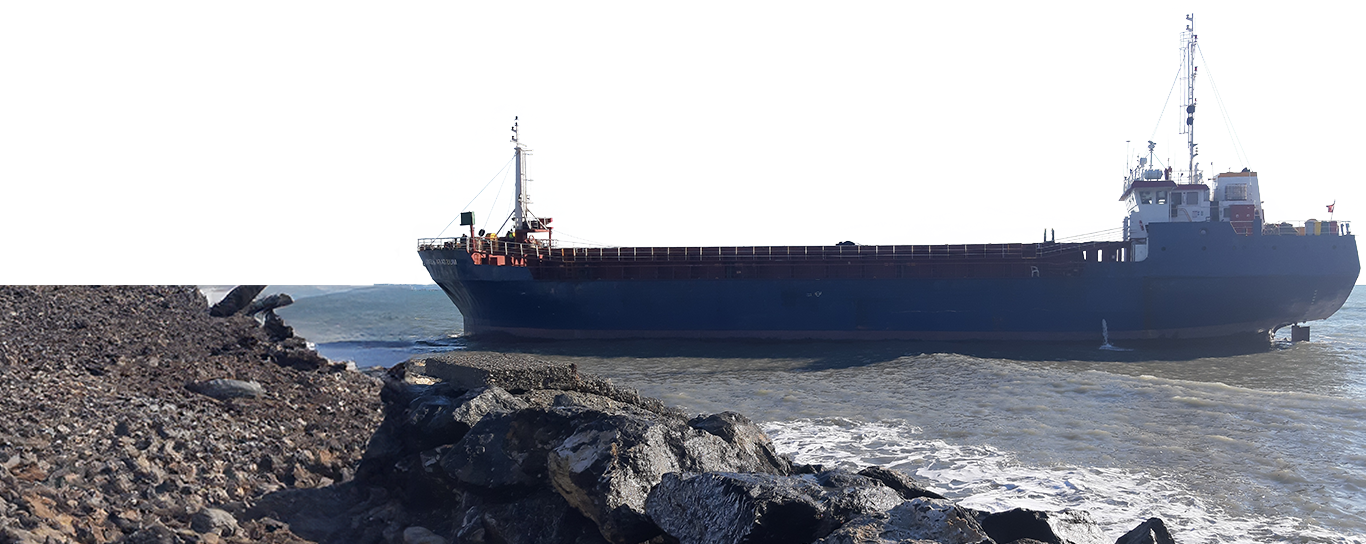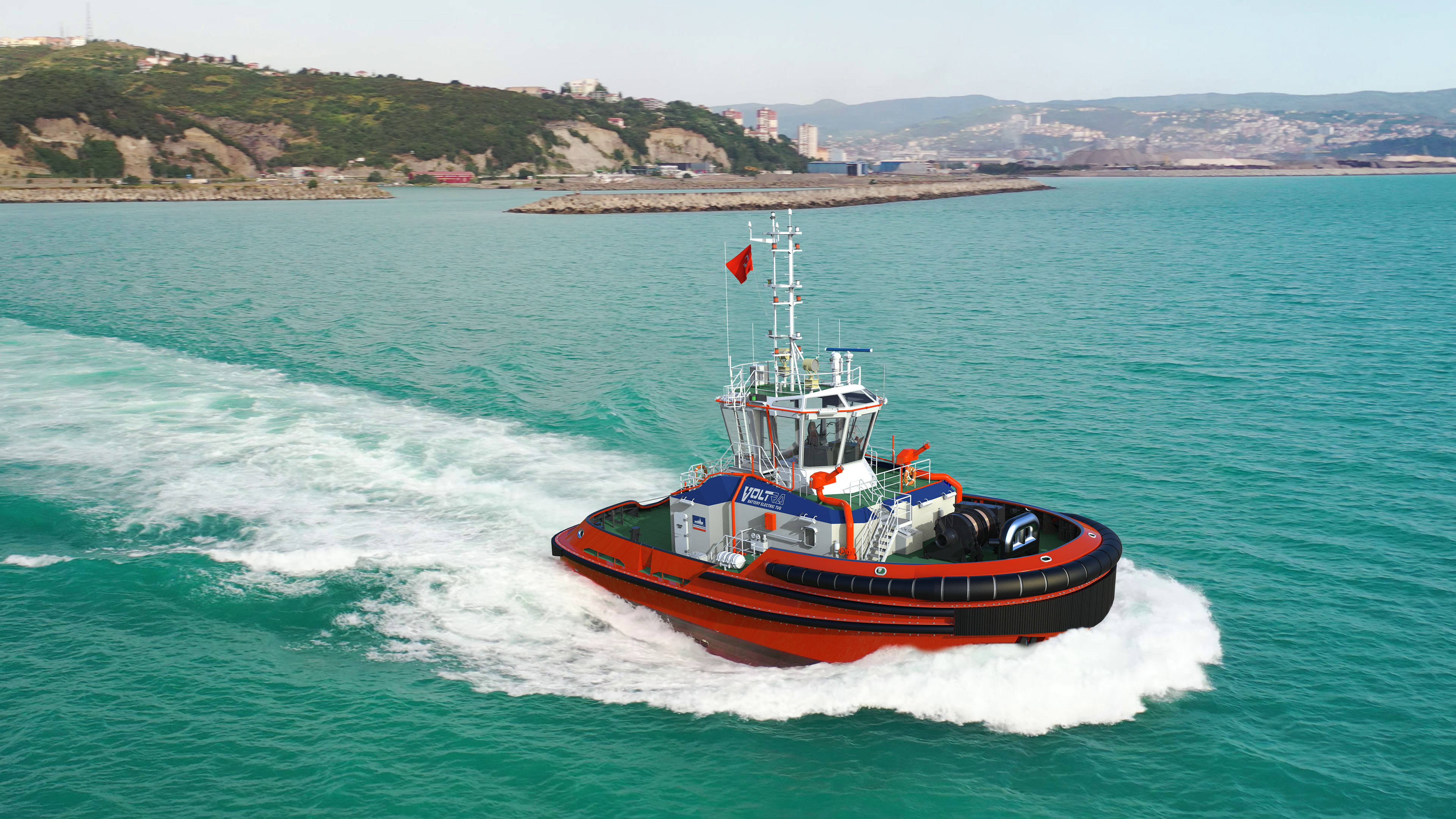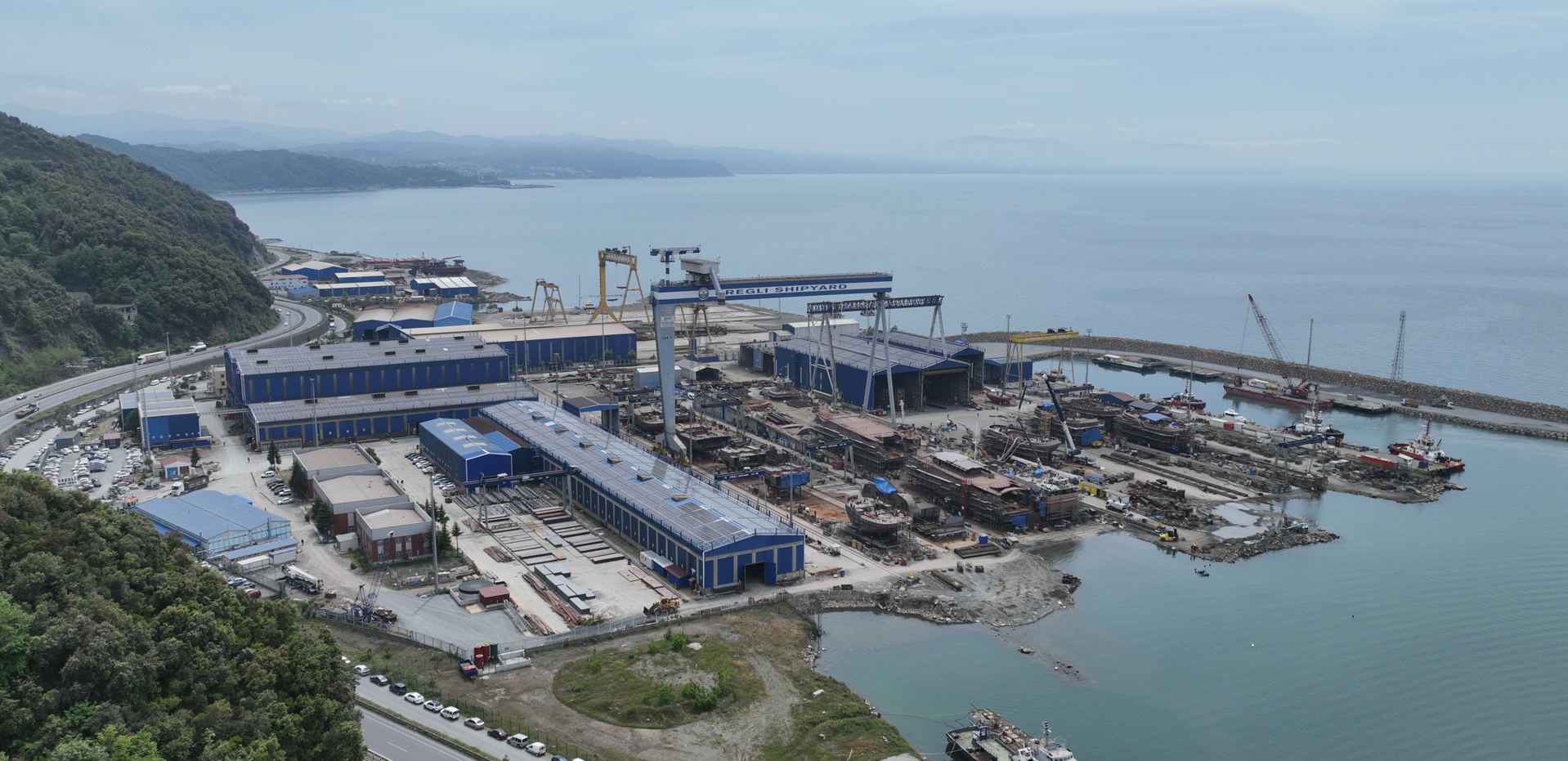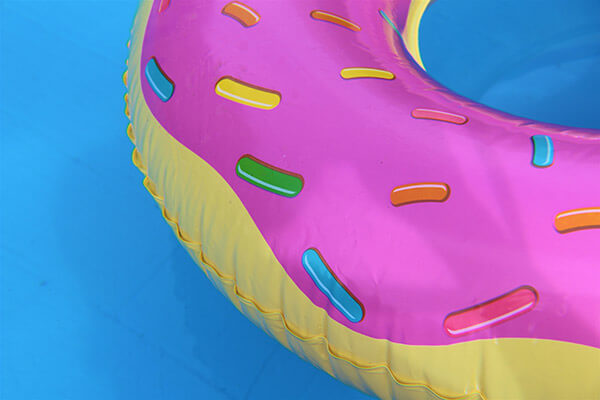13.03.1994
The Cypriot-flagged M/T NASSIA (132,285 DWT) collided with the Liberian-flagged bulk carrier M/V SHIPBROKER in the Bosphorus Strait. M/T NASSIA, carrying approximately 98,700 tons of Russian crude oil, was rammed portside by M/V SHIPBROKER. The collision caused damage to tanks and compartments, followed by a major fire and explosion.
M/T NASSIA, severely damaged and ablaze, was maneuvered to prevent further disaster but eventually grounded off Dikilikaya. M/V SHIPBROKER, having executed a hard port turn prior to the collision, continued out of control, transiting the length of the Bosphorus before grounding at high speed at Anadolukavagi.
The incident resulted in a major oil spill, significant pollution, loss of life, and one of the most complex emergency responses in the history of the Bosphorus.
Environmental Impact & Response:
-An estimated 100-500 tons of oil and emulsion were released, spreading south through the Bosphorus and into the Black Sea due to wind and currents, heavily impacting coastlines like Karaburun.
-A major multi-agency response was launched, coordinated by a Crisis Committee led by Turkish authorities (Ministry of Environment).
-International experts from ITOPF, REMPEC, and CEDRE provided technical advice on site. The salvage and pollution response was funded and coordinated by the Skuld P&I Club.
-Initial offshore containment and recovery using booms and skimmers by the Oil Spill Service Centre (OSSC) collected an estimated 120 tons of waste oil and mousse.
-The focus later shifted to extensive shoreline cleanup of affected areas like Beykoz, Sarıyer, and Rumelifeneri, managed by specialists using manual methods and vacuum trucks.
Med Marine's affiliate, Omur Salvage, was involved in the complex emergency response following the incident. The operation involved firefighting, pollution control, and wreck removal, marking it as a landmark case in maritime emergency management.
09.04.1994
The Turkish-flagged general cargo vessel M/V ÇİNE (1,593 GRT) ran aground off Taşucu, Mersin, while laden with 1,001 tonnes of boxed citrus fruit. The vessel grounded at position 36°13.94'N, 33°56.92'E, developing a 7.5° port list. Underwater inspection revealed the vessel was stuck in a sticky mud seabed, with its port bilge keel buried 1.5 meters.
Med Marine's affiliate, Omur Salvage, was appointed under the internationally accepted Lloyd's Open Form (LOF) 1990 agreement. The operation faced significant challenges: shallow water depths prevented the use of conventional salvage tugs, and the perishable citrus cargo required constant ventilation, ruling out transshipment.
The innovative salvage plan utilized the shallow-draft tug "Seka-Akdeniz II" (1,125 bhp) to perform a precise dredging and scouring operation around the hull. This was combined with strategic transfer and discharge of ballast and freshwater to alter the vessel's trim and list.
After extensive dredging over 18 hours, the vessel's list gradually decreased. M/V ÇİNE was successfully refloated on 13th April 1994 without using its main engine to avoid damage. It was then towed to a safe anchorage off Taşucu.
A final underwater survey confirmed no structural damage to the hull, propeller, or rudder. The operation was completed by Med Marine's affiliate Omur Salvage successfully, safeguarding the vessel and its valuable, perishable cargo. A Delivery Certificate was signed between the Salvage Master and the ship's Master.
25.03.1995
On March 25, 1995, the 20,382 GRT Chinese-flagged bulk carrier M/V Gu Yuan Hai ran aground off the coast of Moda, Istanbul, following a collision with M/V Barbaros Oktay. The salvage operation was carried out over 24 days by Med Marine's affiliate Omur Salvage, under a “No Cure – No Pay” agreement signed with Türkiye Denizcilik İşletmeleri.
Due to the approximately 70–75 m² damage in No. 2 hold caused by the collision, the vessel faced an imminent risk of sinking. The situation worsened as No. 1 hold also began flooding due to severe storms and strong currents. Once weather conditions improved, detailed underwater inspections and engineering assessments were conducted. As a result, a steel cofferdam measuring 12.80 x 11.20 meters was installed over the No. 1 hold hatch, and the large breach in No. 2 hold was sealed with a steel plate patch. Water in the tanks and cargo holds was subsequently dewatered.
Despite strong currents, winds, and wave action caused by passing vessels, the water level was sufficiently lowered; and on April 16, the vessel was successfully refloated. The salvage operation was officially completed with the assistance of tugboats. Despite the challenging environmental conditions, the risk of sinking, and potential structural failure, Med Marine's affiliate Omur Salvage demonstrated high levels of expertise in engineering, diving operations, and coordination, successfully salvaging both the vessel and its cargo.
11.03.1997
The Turkish-flagged general cargo vessel M/V HACI HILMI II (3989 GRT) ran aground in the access channel to Porto Nogaro, Italy, while carrying 6,202.81 metric tons of steel slabs from Novorossiysk, Russia. The grounding occurred on 11th March 1997. All attempts to refloat the vessel with tugs and engine power at high tide failed, leading to a declaration of General Average.
Med Marine's affiliate, Omur Salvage, managed the operation. A lightening operation was conducted, transferring 24 slabs (508.08 MT) onto a barge using the vessel's gear. This allowed the vessel to be successfully refloated. Due to draft restrictions, the vessel discharged its remaining cargo in Monfalcone, which was then trucked to the original destination. A joint survey confirmed the cargo suffered no damage.
The operation was completed successfully with no environmental impact or third-party claims, showcasing Med Marine's effective crisis management capabilities.
01.02.2020
The Turkish-flagged cargo ship Mustafa Kemal I, with a gross tonnage of 1,533 and a length of 68 meters, ran aground off the coast of Hatay/Dörtyol after being dragged by a storm while anchored. The vessel was rescued by tugboats from Med Marine and safely towed to port.
(01.02.2020)
26.11.2001
The Panamanian-flagged bulk carrier M/V HENG SHAN (169,168 DWT) ran aground off the port of Eregli, Black Sea, Türkiye, while laden with approximately 164,000 tonnes of coal.
The vessel grounded on a rocky seabed at position 41°17.09'N, 31°33.39'E, sustaining severe damage to its bottom structure. The forepeak tank and four double-bottom tanks were breached, and the vessel developed a 4.2° starboard list.
Med Marine's affiliate, Omur Salvage, was appointed on a "No Cure - No Pay" fixed-price contract to conduct the wreck removal operation. The complex operation involved a large-scale lightening of the cargo using floating cranes and lightering vessels to reduce the vessel's ground reaction, followed by refloating and towage.
The vessel was successfully refloated and redelivered to the company at a safe location, completing a major wreck removal project that mitigated significant environmental and navigational risks. The operation was completed with a full team of salvage masters, divers, technicians, and a fleet of support tugs and barges.
10.02.2003
In February 2003, the vessel Alliance Spirit ran aground off the coast of Skikda, Algeria, facing the imminent risk of breaking apart and triggering a major environmental disaster. Appointed by the vessel’s marine underwriters, Med Marine's affiliate, Omur Salvage, promptly deployed a specialized salvage team and a Salvage Master to the scene for emergency intervention.
Upon assessment, the expert team determined that the vessel’s structural integrity was critically compromised and prioritized the safe removal of tons of fuel and pollutants.
Operating under extremely challenging sea conditions and with inadequately equipped support vessels, the salvage team managed to avert a potential oil spill by successfully recovering barrels of oil and chemicals, thus preventing an environmental catastrophe.
This entire operation stands as a textbook example of a successful emergency response, demonstrating how Med Marine with its specialized equipment and 24/7 on-site expert teams, plays a vital role in maritime emergencies and remains indispensable for both life safety, and environmental protection.
26.08.1999
On August 26, 1999, the Panama-flagged tanker SETE ran aground off the coast of Karşıyaka in the Gulf of İzmir. It was reported that the vessel was en route to Spain, carrying approximately one thousand tons of pure olive oil. Despite three weeks of efforts by the shipowner, attempts to refloat the vessel proved unsuccessful. Med Marine’s affiliate Omur Salvage intervened.
The specially equipped tugboat Dilovası VII departed from İzmit and arrived in İzmir to carry out the salvage operation.Prior to the commencement of the operation, all necessary bureaucratic permissions were obtained, and a team of divers conducted inspections to assess the hazards surrounding the vessel. The complex salvage operation began during the night and continued through the early morning hours. At 05:05 a.m. on September 18, the tanker was successfully refloated.
10.02.1999
1970-built, Türkiye-flagged M/T Deniz Ay suffered a catastrophic main engine failure and lost all propulsive power in severe weather conditions (Beaufort Force 8) on February 10th, 1999, soon after leaving Aliaga on the Aegean coast.
The casualty, laden with approximately 5,700 tons of fuel oil, was adrift and at imminent risk of grounding on the rocky Turkish coastline or capsizing due to the violent seas, posing a significant threat to its crew of 24 and the environment.
The salvage operations were conducted under a Turkish Open Form (TOF) agreement by Med Marine’s affiliate Omur Salvage with their salvage tug Ocean Ergun (40tbp) and a dedicated Salvage Master.
The vessel was successfully salvaged, towed first to the safe refuge of Candarli and then onward to Aliaga for safe discharge of its hazardous cargo, before being delivered to Tuzla for repairs on February 25th. The operation successfully averted a major environmental disaster and saved the vessel and its cargo.
09.09.2019
A fire broke out on the wheat-laden cargo ship ‘Kıran Asya’, anchored at Atakaş Port in Hatay’s İskenderun district. Fi-Fi equipped tugboats DP World Yarımca, Ekinciler Port, Capt. Faruk Canbolat, and Med XXVIII promptly responded to the emergency call, tackling the flames and heavy smoke. After 5 hours of coordinated efforts by Med Marine tugboats and firefighting teams from both sea and land, the fire was successfully extinguished.
(09.09.2019)
03.04.2014
The vessel AQUA HERCULES lost its maneuverability while anchored due to fuel depletion and began drifting in heavy sea conditions. Upon receiving a salvage request, the ship was safely towed with the assistance of tugboats. After a 3-day operation, it was anchored at a suitable location under the supervision of a pilot captain.
(03.04.2014)
19.08.2017
1983-built, Turkey-flagged, general cargo vessel Ikra (IMO 7901837) reported a danger of sinking as a result of water ingress in the engine room at around noon local time on August 18th, soon after leaving Iskenderun on the Eastern Mediterranean coast.
Ten crew were evacuated by Med Marine and the salvage operations were conducted with 4 Med Marine tugboats and 18 Med Marine personnel.
The vessel was salvaged, towed back to Iskenderun and berthed at around 19:00 that evening. As of Sunday morning she remained berthed.
(19.08.2017)
22.06.2017
A 197-meter-long dry cargo ship M/V Global Laguna was fired at the MMK Port in İskenderun. Med Marine intervened in the fire immediately by the instructions of the Port Authority.
The fire broke out on the Panamanian-flagged ship named Global Laguna, while unloading the cargo of scrap at MMK Port, one of the longest ports in the Iskenderun Gulf.
The fire was extinguished from the shore and sea with the help of 14 Med Marine personnel and 3 Med Marine tugboats.
(22.06.2017)
Oil Spill-Wreck Removal at Istanbul on 29.12.1999 The last Tier 3 scale oil spill in Turkey, VOLGONEFT 248 has been a defining point and historic moment in handling of such matters. Unlike the earlier spill case, NASSIA, which was much larger in the amount of spilled oil, VOLGONEFT 248 demanded much more competence from our side in dealing with various aspects of the matter.
The authorities assembled under the same roof of a permanent Crisis Committee were much more demanding in response and clean-up programme; the claimants were more numerous and well organized; waste disposal and "how clean is clean" were tougher problems.
Our Company, which had a great effect on reaching a rapid solution by its good local reputation, together with an appointed law office and surveyors and with support of ITOPF, managed to acquire the best overall result for the benefit for the Club.
Istanbul on 13.02.1997 (Wreck Removal Operation) Whist the 308.5 meter long tanker named M/T TPOA with the dwt of 160.000 was being made subject to the maintenance and repair services at shipyard exploded, which caused a number of deaths, severe pollution.
The nature and extent of the incident created a significant public sensitivity as a result of having a broad repercussion in press and therefore strong pressure was applied by both of the non-governmental organizations and the state authorities.
Clean-up operations were conducted all by local means and teams under guidance of ITOPF duly and properly. A large number of claims were handled by an independent law office. Results ensured an absolute satisfaction of the Club, local authorities and concerned parties.
A 9.000 DWT Cypriot cargo carrier that was beached high and dry off Antalya in November 1980. Using only beach gear, we refloated her after an operation that lasted some two months owing to bad weather, official ineptitude and having to be very careful not to further disturb a NATO pipeline that had horizontally impaled the casualty's double-bottom.
Whilst this was before the time of even Istanbul Salvage, it was conducted by Omur Marine, whose members are the founders of both Istanbul and Omur Salvage.
A 4,000 GRT Turkish RoRo that capsized near Mersin in the Autumn of 1985. We salved her cargo and refloated her over the winter period.
A Turkish tanker that sustained bottom damage during passage through the Suez Canal in 1986. We backed the damaged area with water and divers riveted patching to make good the hull's integrity.
In 1988 at Port Said, we attended one of Um Tankers' vessels, a 200,000 DWT VLCC, which had sustained some 25 metres of bottom damage whilst transitting the Suez Canal. We made this damage good and the Tanker's classification Society alloved her to proceed to her destination at Morocco under our command.
A 30,000 DWT Turkish general cargo vessel which, while carrying fertilizer to Mexico, grounded off Fethiye in May 1988. Refloated by a combination of dredging and scouring, though, because there was a large rock in way of the grounding great care was taken not to worsen any bottom damage. Overall the reflotation took 10 days. This was performed under TOF (Turkish Open Form) terms.
A handy size Turkish bulk carrier which grounded off Izmir with a cargo of bulk cement in 1989. Patched below the waterline and refloated her by dredging, the operation taking about 10 days. This claim was submitted to private arbitration in London.
A 100,000 DWT OBO which suffered a flooded engine-room in approximately the same location and at almost the same time as the "ERTUG", whilst fully laden with coal. Although several diving companies were called in from Turkey they were unable to locate the source of the ingress. However, Omur traced it to a jammed hydraulic valve on a sea chest.
This was freed, whereupon the sea chest was sealed, flood waters pumped out and the vessel towed to Tuzla, enabling her cargo to be discharged. This was done on a private lump-sum contract with the ship-owner. This operation took around six days in total.
A 320 TEU container vessel which grounded off Izmir in December 1990. Refloated by a combination of dredging and scouring, the operation taking about 5 days. This was undertaken under LOF.
An 8,750 DWT Maltese bulker which went aground in July 1993 in approximately the same position at Fethiye as "ZIGANA", carrying 9,000 tons of nephline syenite. She was refloated by scouring and dredging and altering her various ballast tanks. This took about 4 days and was done under LOF 90.
A Liberian bulk-carrier of about 35,000 DWT which went aground on rocks off Aliaga in late November 1993, having just discharged her cargo. Matters were complicated as the site of the grounding was within the protection areas of both Petkim Refinery and the national museum due to ancient artifacts and wrecks in the area. Underwater repairs were carried out, including patching and doubling using wood, epoxy and steel as and where necessary.
As she was carrying about 900 tons of fuel oil on board all necessary precautions were taken to prevent pollution. Slops from the flooded engine room were discharged into lightening vessels, barriers and skimmers were positioned, and dispersants were held ready. The refloatation itself took about one week but salvage services lasted for three weeks in total. This case was undertaken under LOF 1990 and included an Article 14 claim.
A Turkish bulk ore carrier of 27,236 DWT which went aground near Samso Island in Denmark in February 1994. Cargo was 18,000 tons of feed-barley. Refloatation involved the discharge of 200 tons of slops and 700 tons of bunkers, dredging and scouring with two tugs. The operation took two weeks, weather and lower than usual tides adversely affecting the situation. This salvage was performed under LOF 1990.
A 132,517 DWT Greek tanker which suffered an explosion and huge fire following a collision in the Bosphorus in March 1994. This massive operation involved major fire-fighting, cooling, inerting, towing, ship-to-ship transfer, vast pollution prevention and continuous stress-calculations throughout. The operation lasted some six weeks during which Omur worked as co-contractors under an LOF 90. This was a very challenging operation where 37 vessels were engaged.
A Turkish coaster of 2680 DWT that went aground off Tasucu in southern Turkey in April 1994, carrying a cargo of fresh citrus produce. Refloatation was achieved through dredging and scouring. The operation lasted some two days. This was done under LOF 1990.
A 3,800 DWT Turkish vessel carrying steel coils that went aground in sand off Taranto in Italy in August 1994. 25,500 lts of fuel-oil was transferred to the "Smith Langawi", she was deballasted and refloated all within five days. This was performed under Turkish Open Form.
A Turkish general cargo vessel of around 3,900 DWT, carrying 3,750 tons of steel products, that went aground on mixed sand and limestone in Bayona Bay, Spain in August 1994. She suffered substantial bottom damage and large crack over frames 68 to 59. Her no.1 centre diesel-oil tank was tidal and she was suffering progressive damage to her no.2 port double-bottom and no.2 starboard oil booms were put in place and sludge and slops were removed. Lightening was affected by the partial discharge of some of the cargo and the casualty was taken to Vigo. This operation took four days and was again performed by Omur under LOF.
A Greek tanker of 1,479 DWT, though in ballast that was almost completely beached at Kilyos near the Northern entrance to the Bosphorus in November 1994. Omur fixed her position with beach-gear and dredged a 100m channel to the casualty.
Then scoured around her, eventually refloating and towing her out to a suitable depth. This operation took two and half months owing to the awful and unpredictable conditions extant in the Black Sea at that time of year. It was performed under private contract with her P&I Club.
A 40,926 DWT Greek bulk-carrier that, following a serious collision,was heavily grounded with a 38,000 ton steel cargo in the Dardanelles in December 1994. Omur fixed her position with a kedge-anchor and two sets of beach-tackle and commenced patching and pumping operations. Following this she was eventually refloated by a combination of trimming, ballasting and lightening and then towed and escorted her to Bandirma.
Pollution-prevention contingency measures were in place throughout, and all the cargo that had been transshipped was washed and subjected to preservation processes. In all the operation took about 40 days.
A Turkish vessel of about 4,500 DWT that, whilst in ballast, grounded on the southern harbour breakwater of Chioggia in Italy in December 1994. As a result her engine-room was flooded and she suffered some bottom damage. The engine-room was pumped dry and correct preservation treatment was applied following refloating. This was undertaken under LOF.
A small Turkish vessel of 1,350 GRT that, with a cargo of aluminium ingots, was drifting out of control off the Dutch coast on new year's Eve 1994. She had been rendered a dead ship by an explosion in her engine-room and, because of heavy weather, subsequently suffered flooding. The "Smith Lloyd" was dispatched and, after a two day rescue tow, brought her safely to Port. This was done under LOF.
A 22,000 DWT Turkish bulk carrier that went aground in sand near Khuna in Bangladesh in March 1995 whilst carrying 11,700 tons of cement. This stranding had damaged her transmission so that she was left without any stern drive. She was refloated, towed and safely anchored at Chittagong following an 8 days operation. Here we co-contracted under LOF.
A 35,124 DWT Chinese bulker, fully laden with steel, grounded and partially sank at Moda following a collision in the Southern entrance to the Bosphorus in March 1995. She suffered a 70 meters gash in her port side, holds 1 and 2 were completely sunk and No.3 was fully tidal because of the No.2/3 bulkhead failing.
She was also in serious danger of breaking up. Omur built a cofferdam around No.1, patched No.2 and discharged N.1 and 2 Double-bottoms and forward ballast tank. She was refloated and taken to Izmit. The operation lasted about 25 days and was performed under Turkish Open Form.
A Turkish cargo vessel of 11,675 GRT that went hard aground while carrying about 10,000 tons of steel coils and 8,700 tons of timber from Ventspils to the Eastern Mediterranean. She was grounded over a length of 50 meters in a busy shipping lane in the Western Baltic.
Lightening was carried out by cargo discharge into a lightening vessel and she was refloated by this, towage and the use of a sheerleg. The casualty was taken to Kalandberg where the discharged cargo was reloaded. This operation lasted some seven days and was performed under LOF.
A 3,200 DWT Turkish cargo vessel that went aground in the Aegean in late December 1995 en-route to Israel with a cargo of bagged cement. Her hull was torn in way of her forepeak towards No.1 hold for five meters. Omur lightened and refloated her and then escorted her to Gulluk near Izmir. The operation lasted some three days and was undertaken under LOF 1995.
A Turkish coaster of 2,965 DWT that suffered main-engine failure in the mid-Mediterranean in late February 1996 and started to drift in very heavy seas with a 10°-12° list. Omur despatched a tug from Valletta, Malta and towed the casualty back there. The operation lasted some two and a half days and was done under LOF 1995.
A Turkish bulker of 12,000 DWT which became a dead ship and started drifting amongst oil-platforms in the middle of the Texel traffic separation scheme off Holland at the end of March 1996. She was laden with approximately 10,800 tons of rice. Omur despatched a tug and towed her to Gdynia, her next Port of call. In all the operation lasted some 8 days and was again done under LOF.
A small Maltese bulker that went aground in the Sulina Canal in June 1996. Tugs were despatched and safely towed the casualty clear. This operation performed under LOF '95.
A small Turkish bulker that suffered engine failure and started drifting in the Mediterranean between Italy and Sardinia. Tug was despatched and vessel towed to safety.
A Turkish bulker laden with steel pallets that grounded at the entrance to Porto Nogaro in the Northern Adriatic in Marc 1997. Omur despatched a salvage team to Italy and by a combination of dredging at lightening the vessel was refloated within three days (previous efforts by local operators had resulted in the casualty being left more and more heavily aground).
A small Turkish product tanker that cought fire in the Bay of Izmit in August 1997. Omur despatched a tug with firefighting capability and the fire was brought under control within half a day. The casualty was then taken under tow and delivered to a place of safety.
A Turkish bulker that went aground off Sarubaya in Indonesia whilst carrying Agriproducts. Co-contracting under LOF'97 to refloat the vessel, this being achieved within six days.
A Turkish bulker that, when loaded with sugar, suffered main-engine failure in the Bay of Biscay. Omur despatched a tug from Spain and vessel was successfully towed to safety. This operation was performed under LOF'95.
A small cargo vessel that went aground in Iskenderun bay in December 1998. Omur refloated her within three days, successfully avoiding pollution to the surrounding coast. This operation was a lumpsum contract.
A 6,000 DWT tanker that fully loaded with fuel-oil, was adrift in heavy water in the eastern Aegean in February 1999. Omur despatched our tug the "OCEAN ERGUN" to render emergency assistance to the casualty, who was delivered to safety with her cargo. This operation was performed under TOF.
A 1,093 DWT tanker that loaded with approx. 954 tonnes pure olive oil was agrounded in Izmir Bay, Turkey on 26 August, 1999. Contracting under LOF '95, Omur despatched its tug "DILOVASI VII" and refloated the casualty by dredging. This operation was achieved within 3 days.
A 27,311 DWT Turkish bulk-carrier loaded with approx 3,000M/T zinc ingot hit in collision in St.Petersburg/ Russia. After sailing, water entered #2 hold to sea-level as a result, this tank being fully tidal. Casualty towed to Gdansk against heavy weather/sea conditions and delivered to dry dock for repair.
A 169,168 DWT capsize bulker that loaded with approx.164.000 tonnes coal was agrounded in Karadeniz Eregli / Turkey on 26th November, 2001. Contracting under "Wreckfixed '99" No Cure No Pay, Omur despatched a floating crane, three salvage tugboats and lightering vessels and refloated the casualty by transshipment.
A 45,800 DWT bulk carrier that loaded with approx. 39,000tonnes cement clinker was agrounded at Red Sea on 21st April, 2002. Contacting under LOF 2000, Omur despatched a lightering vessel, one salvage tugboat and grabs and refloated the casualty by transshipment.
A 48,500 DWT bulk carrier that fully laden with bulk soybean was agrounded at Mississippi River on 11th December, 2002. Contracting under LOF 2000, vessel refloated by transshipment on 23rd December, 2002.
A 24,518 DWT bulk carrier that laden with bulk wheat was agrounded at Alexandria Port/Egypt. Contracting under LOF 2000 and SCOPIC invoked, vessel refloated by transshipment and services terminated on 01.03.2003.
A 70,2227DWT Turkish flagged bulk carrier laden with fertiliser was agrounded at Yesilköy, Istanbul/ Turkey. As this area is monopoly area of the State Salvage Company, our Company executed lighterage operation by means of pneumatic, a special kind of pump in order to prevent any damages to cargo, under a seperate contract being the backbone of the salvage operation.
Approx 8900M/T of cargo has been discharged from the Vessel and reloaded upon refloatation. This operation commenced on 08.03.2003 and completed on 22.03.2003.
A 149,000DWT Panama flagged bulk carrier laden with approx.136,500M/T of iron ore was agrounded at Karadeniz Eregli/ Turkey on 15.03.2003. Contracting under LOF2000 with SCOPIC incorporated dated 17.03.2003, Vessel refloated by lightering approx 6500M/T of cargo and services terminated on 27.03.2003. A floating crane, a lightering vessel, three tugboats, an oil spill response boat, an excavator and a mobile crane with u/w equipment were engaged in the operation.




















